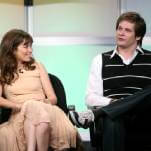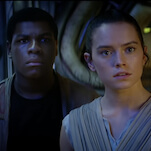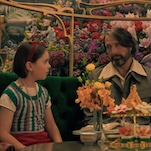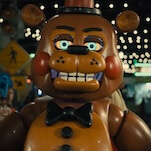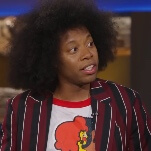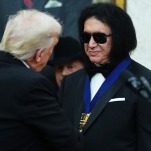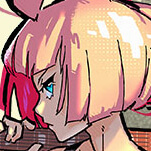Best music: the orphans
Our list of the decade’s best music naturally didn’t cover every album our music writers loved in the ’00s, so we’re giving them the chance to big-up their personal favorites here—these are the discs that didn’t make our big list, but that nevertheless are worthy of your attention. Unless otherwise noted, these are presented in chronological order; the authors want you to love them all equally.
JASON HELLER
Botch, We Are The Romans (2000)
10 tracks – We Are The Romans (Deluxe Edition) (2xCD) by Botch
Released on New Year’s Day, 2000, Botch’s full-length swan song, We Are The Romans, could easily be seen as the sonic embodiment of Y2K anxiety. Really, though, it’s far more nuanced and timeless. Building on the algebraic hardcore of 1998’s American Nervoso, Romans helped set the tone for this decade’s metalcore onslaught, or at least the better end of that spectrum. Richly textured, technically ambitious, funny, ugly, and oddly melodic, the disc was deservedly given the deluxe reissue treatment in 2007—at which point it was clear the world still had yet to catch up with it. (Even though the bands Botch birthed, These Arms Are Snakes and Minus The Bear, have made some great records of their own.)
Owls, Owls (2001)
Cap’n Jazz may have inadvertently helped sire the emo movement in the mid-’90s, but Joan Of Arc—the group that evolved out of Cap’n Jazz—was making some intolerably pretentious post-rock by the time the 20th century ground to a halt. Post-Y2K, most of the Cap’n Jazz lineup (minus Davey Von Bohlen of The Promise Ring) reunited to record under the name Owls. They made only one album, but it was the album of their careers. Fueled by intricate guitars, off-kilter rhythms, and Tim Kinsella’s knotty self-references and inexplicable riffing on the collective lyrics of The Smiths, Owls is a cipher of a record that’s even more challenging, mysterious, and rewarding today than it was upon its release.
Converge, Jane Doe (2001)
12 tracks – Jane Doe by Converge
Everyone has at least one piece of music they associate with 9/11. For me, it’s Converge’s masterpiece, Jane Doe. Released on September 4, 2001, the album has more to do with personal emotional devastation than anything on the scale of the World Trade Center attacks—but the band’s apocalyptic bleakness, shattering blastbeats, and surgical rage certainly suited the mood (or at least my mood) during the final months of 2001. And when singer Jake Bannon and crew do hit the occasional slow groove and fragment of melody—as on “Hell To Pay”—it’s just fucking haunting.
Hot Snakes, Suicide Invoice (2002)
Drive Like Jehu was never fated to do a proper reunion, but with an album like Suicide Invoice, I can live with that. Jehu guitarists Rock Froberg and John Reis met up in 2000, wrote some songs, and released Automatic Midnight, their fantastic debut as Hot Snakes, which dumbed down some of Jehu’s mathier tendencies in favor of a more garage-centric (yet still gnarled) approach. It was good—but on Suicide Invoice, they nailed it. Backsliding into angularity and knuckle-knotting riffs, the disc is a spurting knife wound of pure rock ’n’ roll antagonism with a few sick jokes thrown in for good measure.
The Mars Volta, De-Loused In The Comatorium (2003)
10 tracks – Deloused in the Comatorium by The Mars Volta
At The Drive-In ably ushered in the ’00s with its final album, Relationship Of Command—but it was one of the groups that formed from ATDI’s ashes, The Mars Volta, that dropped the big one. The band’s debut, De-Loused In The Comatorium, is a shotgun wedding of punk strength and prog dexterity that wiped the slate clean for vocalist Cedric Bixler-Zavala and guitarist Omar Rodriguez-Lopez. Teeming with cosmological sprawl, acrobatic musicianship, and some damn fine songs, De-Loused remains one of the high points of the decade. Too bad it’s all been pretty much downhill from there.
Wilderness, Wilderness (2005)
Inhabiting the hitherto undiscovered headspace between Lungfish and PiL, Baltimore’s Wilderness—as its name implies—came out of nowhere with its self-titled debut. Sadly, the band seems to have since disappeared into the same limbo: Although it’s released a couple of decent follow-ups full of its singular, poetic rock, it seems everyone has pretty much forgotten about poor old Wilderness, even as the Charm City scene has blown up. But that’s cool; cult status suits the group, even if Wilderness’ mesmeric, slow-motion drone deserves far more.
Jesu, Conqueror (2007)
I’m not sure whether Jesu’s Conqueror is the best album of the ’00s, but it is by far the one I’ve listened to most. Hell, it even dragged me out of my grumpy-old-man cave long enough to see the band play live—a killer show, especially seeing as how I got to witness Justin Broadrick and company totally bludgeon and confound a couple hundred Isis fans in Tool T-shirts. As for the album itself: Nothing I’ve ever heard, short of Swervedriver’s Raise and My Bloody Valentine’s Isn’t Anything, has combined songcraft, emotion, atmosphere, and overwhelming heaviness with such a sure, hypnotic hand.
Fucked Up, The Chemistry Of Common Life (2008)
11 tracks – The Chemistry Of Common Life by Fucked Up
A grower that’s sure to increase even more in critical stature as time goes by, Fucked Up’s The Chemistry Of Common Life is simply too huge and weird to fully digest in one sitting. Or even 10. But it’s worth the repeats: Built on a solid foundation of crude, classic hardcore, the disc unfurls in about 50 dimensions at once to reveal a tableau of rare, puzzling beauty. Even more importantly, Chemistry swipes much of the indulgence and pretension of the current indie landscape and turns it on its ear, then takes a dump in it.
STEVEN HYDEN
Yo La Tengo, And Then Nothing Turned Itself Inside Out (2000)
13 tracks – And Then Nothing Turned Itself Inside-Out by Yo La Tengo
Because humans measure time using prefabricated, meaningless measuring sticks like “decades,” eras inevitably continue past the point when we decide to end them. The year 2000 really belongs to the ’90s—congratulations on the year’s bestselling album, ’N Sync—but one of the previous decade’s most iconic guitar bands foreshadowed the disaffection and disconnectedness of the new age by making a muted mood record that deconstructed its signature sound and fearlessly alienated longtime fans. (Oh, and Radiohead also made Kid A.) Yo La Tengo’s And Then Nothing Turned Itself Inside Out has been described as a “mature” indie-rock record, which means it’s really just a bunch of pretty, very slow songs about wanting to create a place away from the outside world where it’s always safe and warm. In a way so is Kid A, but this quietly sensual record is better for baby-making.
Guided By Voices, Isolation Drills (2001)
16 tracks – Isolation Drills by Guided By Voices
Back when GBV shows were leaving blackout-sized holes in my memory banks, Islolation Drills was burned into my heart like a UPC code that summed up all there was to know about me. Isolation Drills also said a lot about the otherwise lyrically elusive Robert Pollard. The record was both a thrilling culmination of the former Ohio schoolteacher’s ambition to make indie-sized stadium-rock and a catalogue of the personal losses he endured to get there—particularly the dissolution of his marriage, which he reflected on with rare directness on “The Brides Have Hit Glass.” But this was far from a dour relationship record—on monster-sized slices of red-blooded bombast like “Glad Girls” and “Pivotal Film,” GBV re-imagined The Who as the world’s most transcendent bar band. Like Pete Townshend, Pollard wanted us to get together before we got much older, even if it was to just get wasted.
Jay-Z, MTV Unplugged (2001)
13 tracks – Jay-Z Unplugged by Jay-Z
If I’m wearing my critic’s hat, I’ll argue that The Blueprint is one of the best hip-hop records of the decade. But if I’m talking just as a music fan, I must cop to rocking the house to Jay-Z’s take-no-prisoners live record MTV Unplugged more than practically any other piece of music this decade. Critics are supposed to hate live albums, but MTV Unplugged strikes me as a small miracle, and like Jules Winnfield in Pulp Fiction, I want you to fucking acknowledge it. Jay-Z had no reason to be as flat-out brilliant as he is on this record; setting aside the outmoded Unplugged format, which has inspired memorable performances from bands not named Nirvana exactly this one time, the art of live hip-hop has been eroded so much that fans almost expect rap tours to be canceled before they begin. But for whatever reason, Hova felt he had something to prove here, if only to his terrific backing band The Roots, which made consistently better records this decade than he did, and still ended up playing background music on Jimmy Fallon.
Queens Of The Stone Age, Songs For The Deaf (2002)
15 tracks – Songs For The Deaf by Queens of the Stone Age
The ’00s will go down not just as a historically great decade for metal bands, but also a period of sweeping critical revisionism for a genre that not that long ago was strictly for D&D players and guys too stupid to successfully kill themselves. That’s all great, but I can’t say I enjoy what’s considered “good” metal music these days. I like the melodic, pop-friendly stuff that takes its cues from fake metal groups like Cheap Trick and Stone Temple Pilots over the epic wankery of Maiden and Priest. Which is a long-winded way of saying that Queens Of The Stone Age’s Songs For The Deaf is my favorite metal-tinged hard-rock record of the decade by a mile. Songs For The Deaf will likely be remembered as the best non-Nirvana album that Dave Grohl played drums on, but chief QOTSA architect Josh Homme is the one who deserves a special medal for reviving a classic but sadly forgotten formula: Heavy riffs + big dumb drums + pop melodies = awesome rock ’n’ roll.
Sun Kil Moon, Ghosts Of The Great Highway (2003)
Ghosts Of The Great Highway seems destined to be thought of in the same context as Van Morrison’s Astral Weeks, Nick Drake’s Pink Moon, and Elliott Smith’s Either/Or. All are masterworks by profoundly sad, deeply soulful, mostly mysterious loner geniuses—in the case of Ghosts, it’s former Red House Painters leader Mark Kozelek—that transport listeners into the inner recesses of a singularly troubled, beautifully emotive mindscape that the performer is only barely holding together, because he’s only barely holding himself together. Kozelek has made a lot of records like this in his career, but Ghosts Of The Great Highway stands apart as an album with a depth of feeling that only grows greater with the passage of time.
Ryan Adams And The Cardinals, Cold Roses (2005)
9 tracks – Cold Roses by Ryan Adams
For a while, it looked like Ryan Adams was hell-bent on killing himself—either by his own hand, or via one of the countless people he’s irritated over the past several years. Adams didn’t die in the ’00s, but he was reborn in the middle of the decade when he hooked up with The Cardinals, an exceedingly sympathetic ensemble packed with understated virtuosos capable of following their flaky leader down whatever musical path struck his fancy. Adams unveiled The Cardinals on his expansive, Grateful Dead-inspired double album Cold Roses, which is as much a watershed in his career as the more celebrated Heartbreaker. The Cardinals put Adams in a comfort zone that allowed him to focus on his natural gifts as a singer and melodicist on instant classics like “Magnolia Mountain” and “Easy Plateau,” which paved the way for a series of similarly relaxed albums that would cement his status as one of the decade’s most important singer-songwriters.
Sam Roberts, Chemical City (2006)
10 tracks – Chemical City by Sam Roberts
Sometimes I wonder if I really belong in Canada, because it seems like my fellow Americans don’t appreciate scruffy classic-rock-inspired bands nearly as much as they should. (By which I mean nearly as much I do.) But up north, a magical place where my beloved power-pop powerhouse Sloan returned after inexplicably failing to take over the U.S. in the ’90s, an unabashed trad-rocker like Sam Roberts not only sells tons of records, but also wins Grammys. (They call them Junos up there.) On Chemical City, Roberts sounds like Paul McCartney fronting The Who—seriously, the music is crunchy and melodic, and the guitar and organ sounds are fantastic. Blast it in your car, and you’ll be yearning to cross the border by the time “Mind Flood” is flooding your mind.
Todd Snider, The Devil You Know (2006)
11 tracks – The Devil You Know by Todd Snider
Released at a time when empathy was considered a dirty word in political discourse, Todd Snider’s The Devil You Know was like an island of decency in a pool of sewer water. Thank God it’s also really funny. If you’re going to take a dose of reality, it goes down easier coming from a wisecracking hippie with a stoned grin and an affinity for the faceless undesirables that the rest of our culture was all too happy to throw away the past 10 years. Snider’s rogue’s gallery of characters—the coked-up pool hustler in “Just Like Old Times,” the ex-con stuck putting up drywall for assholes in “Looking For A Job,” the car thief on the run from the cops in the title track—were just trying to make it in Bush’s America without their souls being completely crushed. I think I made it out okay. How about you?
[pagebreak]
SPENCER KORNHABER
Deftones, White Pony (2000)
12 tracks – White Pony by Deftones
Nü-metal reached a crest early this decade, then mostly died; it’d be nice to think that happened because the genre’s smartest fans used White Pony as a gateway to far better music. If you’re going back for a listen, lop off the “bonus” opener “Back To School”—Chino Moreno was clearly trying and spectacularly failing to write a song that would make him lots of money—and start with the sleepy-mouthed kidnapping narrative “Feitceira.” At a thematic level, the album is a catalog of sexual fantasies, but its real success is in demonstrating how hard rock for thugs can be mutated anew to create 11 distinctive, immersive songs where atmosphere serves as medium and message.
The Blood Brothers, Burn, Piano Island, Burn (2003)
14 tracks – Burn, Piano Island, Burn [Bonus Track Version] by The Blood Brothers
These Seattle hardcore heretics released half a dozen albums, but that doesn’t stop Burn, Piano Island, Burn from feeling like one of those seminal debuts from a band that never releases another. Everything is here: Two spectacularly abrasive squealers, 12 poems of Dadaist gore, songs contorted to only passingly resemble punk or metal, and, most importantly, a real sense of lightness. It’s a hilariously hideous-sounding album, but there’s a trick that makes it all make sense: Try dancing to it. The Blood Brothers’ greatest coup is that, under layers of migraine-inducing guitars, coked-out dynamic shifts, and lyrics about “bulimic rainbows,” Burn, Piano Island, Burn was really meant to sway hips.
Squarepusher, Ultravisitor (2004)
15 tracks – Ultravisitor by Squarepusher
Tom Jenkinson was one of the biggest hipster/electronica crossover artists in the 1990s, but back then, it seemed that what blew minds was the ability to layer beats quickly and weirdly. (See Aphex Twin or Autechre.) This decade has seen Intelligent Dance Music subsumed in popularity by Emotionally Intelligent Dance Music (a genre I just made up), which makes it surprising that Ultravisitor didn’t get more attention. It’s a deeply felt album. It’s cohesive, dense, and completely inscrutable in its artistic choices—Jenkinson piped crowd sounds into the studio while swinging between melodic noisiness and meditative guitar passages—but it’s completely comprehensible in its impact. It imparts terror and joy, melds analog and digital, and, best of all, features “Steinbolt,” an anthem proving that electronica may be the last frontier for headbangers.
The Hold Steady, Boys And Girls In America (2006)
11 tracks – Boys And Girls In America by The Hold Steady
Not to knock Separation Sunday or Almost Killed Me (though maybe to knock Stay Positive a little), but Boys And Girls In America is where Craig Finn finally proved he wasn’t just a voyeur: The problems of hoodrats and the problems of John Berryman, he says, are one and the same. The album seems more thematically cohesive than its predecessors, but maybe that’s simply because it’s less dense and more pop-driven. But that certainly isn’t a bad thing: Has any band this decade produced anything as simultaneously wall-kicking and heart-breaking as “You Can Make Him Like You”? It just seems right for The Hold Steady to write songs that the kids at prom can shout along to. After all, Finn’s thesis is that everyone has one great night that will haunt the rest of their lives; you can never get as high as you got.
Radiohead, In Rainbows (2007)
10 tracks – In Rainbows by Radiohead
Forget the release model and forget all the hedged, “gosh it’s pretty” reviews. In Rainbows isn’t merely a tidy summation of the band’s work, and it isn’t just nice. It’s a statement, right down to its title, about transitivity and the things that don’t endure. Love. Friendship. Enjoyment. Life gets in the way of the good stuff: There’s betrayal (“15 Step”), infidelity (“House Of Cards”), and most devastatingly, the passage of time and the dimming of affinity (“Reckoner”). Nothing lasts, Yorke says, so experience what you can now, and trust that you’ll have a videotape at the end.
MICHAELANGELO MATOS
Lifter Puller, Fiestas + Fiascos (2000)
12 tracks – Fiestas + Fiascos by Lifter Puller
Of course The Hold Steady made it onto the big list, and Separation Sunday was high on my list, but for my money, Craig Finn’s greatest album remains this ridiculous, sui generis, breathless half-hour scrap-a-thon, full of miscreants, needling synth riffs buttressing grinding guitar, and hapless narrators who do things like “[waking] up in the grass with the assless chaps.” Plot: low-level lowlifes set out to destroy nightclub. Weapons: drugs, wanton sex in cabs, and jerks who bray things like, “Think about what you’ve got, compare it to what I’ve got, and ask yourself, what do you think my girl wants?” Weirdly, everyone has a good time anyway.
Bob Dylan, Love And Theft (2001)
14 tracks – Love And Theft by Bob Dylan
The funniest line on this funny album is from “Summer Days”: “She says, ‘You can’t repeat the past’ / I say, ‘You can’t? / What do you mean, you can’t? / Of course you can.’” It’s the delivery—Dylan whams it out so quickly, you might instinctively rewind it just to be sure you caught everything—but it’s the sentiment, too. Love And Theft not only rewrites half a dozen strains of blues and pre-rock pop expertly, it rewrites Dylan’s persona as well. Here, he’s an old-time rounder with a band that can grab a riff and wring it for everything it’s worth, and even if his voice is hacked to pieces, he’s still astounding in his wryness, warmth, and card-sharp’s timing. The net effect isn’t like anything Dylan ever recorded before—he repeats the past in order to escape it, and gets away clean.
Sonic Youth, Sonic Nurse (2004)
10 tracks – Sonic Nurse by Sonic Youth
Don’t call it a comeback; they’d been here for years. But that makes it too easy to take Sonic Youth for granted, and this stands as one of their greatest albums. Its ingredients weren’t unusual: pop-culture lyrical references (“Kim Gordon And The Arthur Doyle Hand Cream” speculated about Mariah Carey), the parched vocals of Gordon, Thurston Moore, and Lee Ranaldo, and of course the squalling, layered guitars of all three. (Jim O’Rourke was on bass for the last time.) But the renewed vigor of 2002’s Murray Street goes cruising here: Sonic Nurse grooves hard (check “Pattern Recognition” and “Stones”) and sounds totally assured, even on the spooked ballad “I Love You Golden Blue.”
The Mountain Goats, The Sunset Tree (2005)
13 tracks – The Sunset Tree by The Mountain Goats
John Darnielle had a hell of a decade: Home-taped grabbers like 2002’s All Hail West Texas led to a remarkably consistent string of studio albums for 4AD, beginning with 2002’s rattling Tallahassee (featuring the unforgettable “No Children”), even writing what may be the best volume of Continuum’s 33 1/3 book series, a searing novella about Black Sabbath’s Master Of Reality. But The Sunset Tree, the first album Darnielle wrote explicitly about his own experience, was the heart-stopper, a song cycle about living in the shadow of an abusive stepfather and eventually coming to not just accept the memory, but to mourn his passing. Even when it’s quiet, these songs are fleet, brilliant, and indelible; the situations they describe might be tough to take, but the music is bold, fully alive, and as easy to go back to as a long drink of water.
The Go-Betweens, Oceans Apart (2005)
10 tracks – Oceans Apart by The Go-Betweens
The news that Grant McLennan died in his sleep on May 6, 2006, hit doubly hard, because he’d just made what might have been his greatest album. Oceans Apart was the third album from McLennan and fellow Go-Between Robert Forster since their 2000 reunion, and it’s easily the most confident and beautifully written. Every song is a gem, and each songwriter bolsters the other—it’s like listening to an exceptionally astute conversation between two old friends, full of casual wisdom, sly jokes, and startlingly acute memories, all set to memorable tunes. At its heart is McLennan’s “Finding You,” one of the most uncanny power-of-music odes ever written: “What would you do if you turned around and saw me beside you / Not in a dream but in a song / Would you float like a phantom or would you sing along?” R.I.P.
Ne-Yo, Year of the Gentleman (2008)
12 tracks – Year Of The Gentleman by Ne-Yo
“Grown and sexy” was the decade’s great R&B cliché, but no one explored that phrase’s implications with Ne-Yo’s precision and care. When he wasn’t writing defining hits for Beyoncé (“Irreplaceable”) and Rihanna (“Unfaithful”), he made a trio of superb albums, and this, the third, is where he got serious. For all the hit singles it spun off (which is fewer hit singles than it could have), Gentleman is a capital-A Album, sequenced with as much precision and care as the songs themselves. Who said great singer-songwriters had to sound like folkies?
Erykah Badu, New Amerykah Part One (4th World War) (2008)
11 tracks – New Amerykah Part One (4th World War) by Erykah Badu
Truly visionary funk is a rare, precious commodity, and New Amerykah was bursting with it: grooves that were audacious not simply for their bumptiousness, but because they got away with more than most people even try. “My People” is as cockeyed-futuristic as prime Sun Ra; the Georgia Anne Muldrow collaboration “Master Teacher” sounds like a distaff Last Poets fronting Cosmic Slop-era Funkadelic; “Me” segues from ruminative neo-soul into a coda that sounds like the friggin’ Raincoats. “Hip-hop is bigger than the government,” she croons on “The Healer.” On New Amerykah, Badu sounds bigger than that.
[pagebreak]
JOSH MODELL
Crooked Fingers, Crooked Fingers (2000)
10 tracks – Crooked Fingers by Crooked Fingers
After Archers Of Loaf split up, singer-guitarist Eric Bachmann chased his muse in whatever direction it wanted him to go, all under the name Crooked Fingers. For his debut using the new name, Bachmann kept it simple and spare, marrying warm electronic touches to simple, sad songs. Each subsequent disc—there are now five terrific CF albums, plus a great mellow one credited just to Bachmann—traveled a slightly different path, from Spanish-flavored (Dignity & Shame) to more straight-up rock (Forfeit/Fortune). But when they’re all this good, there’s no reason not to start at the beginning.
Clem Snide, Your Favorite Music (2000)
12 tracks – Your Favorite Music by Clem Snide
The release of Clem Snide’s reserved second album was probably a bit too quiet for the band’s taste: It came out very briefly on Sire—the legendary Seymour Stein had courted the band—but the label dropped the band almost immediately. But they couldn’t keep something so ingratiatingly somber down: Your Favorite Music was quickly reissued, and it began a string of excellent discs—though none as peaceful and gorgeous as Your Favorite Music’s “Bread” and “Exercise.”
Andrew W.K., I Get Wet (2001)
12 tracks – I Get Wet by Andrew W.K.
Andrew W.K. is an absolutely confounding performer, which, hilariously, tends to make some people mad instead of just confused and/or happy. But open hearts can’t possibly refuse the insane, multi-layered electro-pop of I Get Wet, the album that launched a million parties. Not every single track is a winner, but “Party Hard” and “It’s Time To Party” are indelible pop moments that should’ve been much bigger hits than they were.
The Dismemberment Plan, Change (2001)
11 tracks – Change by The Dismemberment Plan
There’s little disagreement among The Dismemberment Plan’s fans that 1999’s Emergency & I marked the height of the D.C. band’s powers. But Change, the band’s final album, was like that disc’s morning-after. It’s grown-up but not entirely comfortable yet, and slick in ways, but never sterile. On top of that, it has The DP’s often-imitated, never-duplicated sound: D.C.-inspired indie-rock with the kitchen sink thrown in.
Low, Things We Lost In The Fire (2001)
13 tracks – Things We Lost In the Fire by Low
I’ll start by saying that there isn’t a Low album I wouldn’t recommend: The Minnesota trio has carved out an incredible career that began by simply playing slowly and quietly, but evolved into something different. Things We Lost In The Fire and its companion piece, 2002’s Trust, found Low stretching out into the slightly more rocking territory that the group would flesh out with The Great Destroyer and Drums And Guns. There’s still an incredible gentleness at work on Things We Lost, particularly on one of the band’s best songs ever, “In Metal.”
The Decemberists, Castaways And Cutouts (2002)
10 tracks – Castaways and Cutouts by The Decemberists
Not to be that guy, but The Decemberists sounded so much better when they weren’t trying to bring prog—and epic storytelling—to the their sweeping orch-pop. Sure, Castaways, the band’s debut, tends toward anachronism, but it’s tempered by absolutely indelible pop songs like “Leslie Anne Levine” and “July, July”—a pair The Decemberists have yet to match, and which don’t rely on some overblown narrative arc to keep them interesting.
Snow Patrol, Final Straw (2003) / Coldplay, Parachutes (2000)
12 tracks – Final Straw by Snow Patrol
For those who don’t shy away from the epic, radio-friendly end of what was once called alternative music, the breakthrough albums by Snow Patrol and Coldplay offer gorgeous bits of fizzy ear tonic. Final Straw was a worldwide smash, and for good reason: Its rafter-reaching singles “Run” and “Chocolate” manage to be grand, personal, and smart. Ditto for Coldplay, just a bunch of scrappy English lads led by a goofy dude with a tall ’fro when they first started. They’ve grown too comfortable with superstardom, but songs like “Don’t Panic” and “Trouble” have stood the test of time.
Cat Power, You Are Free (2003)
14 tracks – You Are Free by Cat Power
You Are Free jumped on and off our big list several times throughout the process, so consider it number 51. Chan Marshall started to crest with 1998’s Moon Pix, an album that bubbled for nearly five years while she worked on her next set of original songs. You Are Free was worth the wait, particularly the songs “Good Woman” (which features a sorta-uncredited Eddie Vedder on backing vocals), the jarringly gorgeous album-opener “I Don’t Blame You,” and the simply jarring “Names.”
Bloc Party, A Weekend In The City (2007)
13 tracks – A Weekend In The City by Bloc Party
Bloc Party’s second album was surprisingly divisive, at least on The A.V. Club’s message boards. The British band’s debut, Silent Alarm, was roundly praised, but a fairly sharp turn into darkness—both musically and lyrically—on Weekend turned dance-rock fans off. But spend a little time with it—it’s a great headphones record—and it’s ultimately rewarding, weird, and wonderful. It might be the one they’re remembered for.
Frightened Rabbit, The Midnight Organ Fight (2008)
14 tracks – The Midnight Organ Fight by Frightened Rabbit
This disc may be too recent for people to have considered it in the bigger picture, but Frightened Rabbit’s second album will have staying power: It’s a wiry, weird collection that removes that pesky emotional detachment from indie-rock’s best intentions.
NOEL MURRAY
Tied for first:
Arcade Fire, Neon Bible (2007)
The Hold Steady, Boys And Girls In America (2006)
The New Pornographers, Electric Version (2003)
Phoenix, It’s Never Been Like That (2006)
Radiohead, In Rainbows (2007)
Spoon, Ga Ga Ga Ga Ga (2007)
The Walkmen, A Hundred Miles Off (2006)
The White Stripes, Icky Thump (2007)
Wilco, A Ghost Is Born (2004)
11 tracks – Neon Bible by Arcade Fire
All of the above albums are by artists who made our Top 50 with other albums, and while I don’t have a problem with the items that made the official list, these are the records I voted for. In most cases (Phoenix excepted), my colleagues went with earlier releases, which makes sense from the standpoint of weighing historical/cultural significance. (Yankee Hotel Foxtrot was more important than A Ghost Is Born, White Blood Cells had more impact than Icky Thump, and so on.) But while I’m not a contrarian by nature, I honestly prefer all these albums to the ones on our official list. Maybe it’s that I’m partial to the idea that the best artists either progress or refine; in the above records, I hear musicians using what they’ve learned in order to express something new about themselves and their craft. Or, alternately, perhaps I’m just a sucker for novelty, and I prefer these records because they haven’t been played to death. I confess that two of these—the ones by Spoon and The Walkmen—I gave reserved reviews to when they were originally released. Maybe in that process of dismissing a record only to discover that I underrated it, I’m now, perversely, overrating it. It’s impossible for me to say for sure. All I know is that there was nothing calculated about these choices. These are the albums I love best by the artists in question. The heart votes how it votes.
And nine more (in alphabetical order)…
Ryan Adams, Love Is Hell (2004)
16 tracks – Love Is Hell by Ryan Adams
The problem with Ryan Adams is that while he’s responsible for some of this decade’s best songs, his albums have nearly all been problematic to some degree. Even the good ones—Cold Roses, Easy Tiger—have their share of missteps or bland filler, and throughout the decade, Adams has gone through periods where he’s released too much material, and periods where he promises masterpieces that never materialize. Love Is Hell is, in my opinion, Adams’ most consistent album of the ’00s, even though it’s so unlike his usual style that his label initially tried to bury the record by splitting it into two EPs. Love Is Hell finds Adams giving full vent to his Britpop and Jeff Buckley obsessions, turning out a set of songs that alternate between stillness and ripples. Sometimes Adams’ genre exercises can come off as half-baked, halfhearted, or his drunken idea of a joke. But Love Is Hell is profoundly sincere, and like the music Adams pays homage to, it’s ideal for rainy days, late-afternoon drives, and wallowing in heartbreak.
Belle & Sebastian, Dear Catastrophe Waitress (2003)
12 tracks – Dear Catastrophe Waitress by Belle & Sebastian
Just when Belle & Sebastian seemed to have settled into a comfortable rut, pumping out a succession of droll rockabilly lullabies tinged with acid, bandleader Stuart Murdoch abruptly embraced eclecticism. Dear Catastrophe Waitress expanded the band’s range of influences dramatically, augmenting the usual B&S-style ditties with elements of boogie, glam-rock, R&B, disco, and post-punk. Some old fans balked—frankly, I balked when Murdoch went even further out with the next B&S album, 2006’s scattershot The Life Pursuit—but Dear Catastrophe Waitress was a necessary step into new territory for a band that could’ve quickly slid into irrelevancy. And it’s a killer collection of songs to boot.
Desaparecidos, Read Music/Speak Spanish (2002)
9 tracks – Read Music / Speak Spanish by Desaparecidos
Conor Oberst only recorded one full-length album with his punk-minded Bright Eyes offshoot Desaparecidos, but it’s a doozy of a record: nine songs, just over 30 minutes long, and as focused and angry as just about any other music emerging from Oberst’s generation at the time. Released just a few scant months after 9/11, Read Music/Speak Spanish is refreshingly bold in its explication and excoriation of American consumerism. The music is cacophonous but melodic, and in some ways matches Oberst’s loud quaver better than his more staid Bright Eyes folk-rock. At the least, the Desaparecidos sound synchs up well with lyrics that tackle the uneasy struggle between activism and trying to make a living. “Never mind the shit that I sing about,” Oberst spits at the end of the record, “Because I’d sell myself to buy a fucking house.” It was as thrilling then as it is now to hear a protest singer include himself on his enemies list.
Lambchop, Nixon (2000)
Kurt Wagner’s country-soul orchestra Lambchop spent the ’90s as one of a legion of indie bands making small, personal records for audiences largely composed of fellow musicians and rock journalists. The heyday of indie-rock (as a business model, not a genre) ended right around the turn of the millennium, and as though sensing the shift, Lambchop made an astonishing leap in style and assurance on album No. 5. Nixon synthesizes Wagner’s influences—the ’60s countrypolitan sound, ’70s R&B, musique concrète—and applies them to his philosophy of artistic creation, which prizes documenting the fleeting thoughts of the passing day. Lambchop recorded one fantastic album after another in the ’00s, but Nixon made such a strong impression that even though not that many people actually heard it, it still feels epochal.
Marah, Kids In Philly (2000)
11 tracks – Kids In Philly by Marah
Marah’s first album was a charming, low-key roots-rock effort, but the Philadelphia band’s second album, Kids In Philly, cranked up the urgency, starting with the sound of an alarm before launching into a tumble of banjo, guitar, bells, and drums, played at a breakneck pace. Bruce Springsteen is a clear influence here, as is early-’70s Van Morrison, and Motown in its brief “social conscience” era, but as Marah has gone on to a niche career of wildly varying quality, Kids In Philly seems increasingly like the one true expression of the Bielanko brothers’ shared sensibility. The Bielankos dumped all they knew about urban life and social history into 37 minutes of vivid story-songs and character sketches. Every album since has just been variations on a theme.
Life Without Buildings, Any Other City (2001)
-1 tracks – Any Other City by Life Without Buildings
One problem I had with putting together my best-albums-of-the-’00s list is that I tend not to think in terms of “albums” much anymore. When I get a new CD, I play it straight through a few times, then dump my favorite songs from it into an iPod playlist and file the disc away. There have been a few exceptions in the ’00s, but often a “good album” for me is one with five or six songs that sound awesome on shuffle. Filler isn’t much of a detriment. (Cf. my enduring affection for Adams, Ryan.) In the case of the one and only studio album by Glasgow art-rock outfit Life Without Buildings, the stumbling block to enthusiastic recommendation isn’t so much an excess of weak songs—all 11 are pretty great, in fact—so much as that the band’s mix of skittery guitars, odd tempo-changes, and the trilling raps of pigeon-voiced vocalist/lyricist Sue Tompkins can get exhausting after 15 minutes or so. And yet I’ve kept Any Other City in its entirety on my iPod for almost a decade now, because there’s never a time when an LWB song—any LWB song—doesn’t improve my day. This was a great decade for Scottish rock, and Life Without Buildings was right there in the mix… if only in small quantities.
The Notwist, Neon Golden (2002)
13 tracks – Neon Golden by The Notwist
I got my first real lesson in how technology was changing everything about music—from the creation to the distribution to the hype—with my exposure to The Notwist’s beautiful Neon Golden. I heard the band for the first time thanks to a couple of mp3s posted on the blog of a virtual pal (someone who was part of an online discussion group I took part in, but whom at the time I’d never met) and then I ordered the then-import-only CD from Amazon, and enjoyed a set of songs that sound as though they were pieced together one note at a time by some guy with a laptop in a cramped European flat, in the wee hours of the morning (while trying to keep the noise down). Neon Golden almost sounds like a blog in electro-pop album form, recording impressions of a confusing life for an audience of close friends and total strangers.
Reigning Sound, Time Bomb High School (2002)
15 tracks – Time Bomb High School by The Reigning Sound
The decade began with a White Stripes-fueled interest in neo-garage, but the craze petered out quickly, even though the Stripes remained stars. Also still standing? Greg Cartwright, who’d been one of the leading lights of ’90s neo-garage and spent the ’00s mentoring others in between recording all-too-infrequent albums with his own band, Reigning Sound. Time Bomb High School was a revelation when it was released in 2002: a raucous rock ’n’ roll record that expands the parameters of garage-rock to include The Rolling Stones, The Rascals, Sam & Dave, and Charlie Rich. It’s a joyous collection of covers and originals, rendered all yelpy and beat-crazy, and it’s one of those albums that people can’t wait to pass along to grateful friends. Even more incredibly, Reigning Sound’s new album, Love And Curses, is almost as good, as is its rough-hewn Time Bomb follow-up, Too Much Guitar, which sounds like an attempt to make a neo-garage version of My Bloody Valentine’s Loveless.
Brian Wilson, SMiLE (2004)
18 tracks – Smile by Brian Wilson
It’s a mistake to think of the re-recording and reconstruction of The Beach Boys’ scrapped masterpiece SMiLE as the final, official version of the record. The many bootleg versions of the original SMiLE sound more inventive and puckish than this more straightforward take by Wilson and members of The Wondermints, and the 2004 SMiLE doesn’t add much that hardcore Beach Boys fans hadn’t heard in earlier forms. Still, not everyone haunts the grey market, so it’s great to have some of Wilson’s best songs (written with Van Dyke Parks) available in their proper context, serving as part of a treatise about healthy living and the history of American music. And in a way, the somewhat more reserved tone and statelier atmosphere of the final SMiLE adds a dimension to the project that it never had before. This isn’t some young person’s folly anymore; it’s an older man reclaiming his legacy after too many years in exile. Good vibrations indeed.
[pagebreak]
SEAN O’NEAL
The Dears, No Cities Left (2003)
11 tracks – No Cities Left by The Dears
Plenty of people dismissed The Dears’ melancholy, grandiose sophomore album as just another attempt to whip out gladiolas and flog the worked-over horse of post-Morrissey Britpop—to which I say, “And…?” I happen to like post-Morrissey Britpop, and if anyone—let alone a black Canadian named Murray—can ape its effete, debonair atmospheres so unapologetically, while still producing a record that may be ersatz in its affections but so unimpeachable in its emotions, I say more power to them. How many Rolling Stones clones have we suffered through, for fuck’s sake?
Tom Vek, We Have Sound (2005)
10 tracks – We Have Sound by Tom Vek
One of the worst things to happen to music this decade was the democratization provided by ProTools and the like, which allowed every garage-rock band in the world to fine-tune its shitty songs to a deceptively “radio-ready” gloss. On the other hand, the leaps and bounds in home recording also gave us albums like We Have Sound, whose oddly tinny, loping drum patterns and strangled-into-submission guitars never would have escaped any discerning engineer, and thus would have lost all of their immediate charms. Vek’s stark, late-’70s post-punk influences are so obvious that they don’t even require name-checking; if you’ve been awake this decade, you can rattle them off. But it’s the natural way they roll off his droll tongue, and the way their disparate elements are synthesized into a singular, graceful cool (for lack of a better word) that makes We Have Sound unique among those many bands trying desperately to be Gang Of Four in the mid-’00s. That, and the fact that there’s barely a bum note in the lot. No wonder he’s spent the last five years trying to follow it.
Antony And The Johnsons, I Am A Bird Now (2005)
10 tracks – I Am A Bird Now by Antony & The Johnsons
Equal parts Bryan Ferry, Nina Simone, and Arthur Russell (three of my favorite singers), Antony Hegarty’s voice may be melodrama personified, but it’s also incredibly beautiful—and that makes some people uncomfortable, which I totally understand. And yes, his self-titled debut admittedly wavered ever so slightly into cabaret camp, but with I Am A Bird Now, he left behind all those performance-art put-ons and took a far more honest tack, meditating on universal themes of death, loneliness, and confusion in a way that was both incredibly brave—as he himself mused around the time of its release, “Hope and sincerity are the new punk”—and heart-stilling in its unabashed beauty. He also did it without ever dipping into overwrought angst, no matter what detractors (who obviously aren’t really listening) may claim.
Liars, Drum’s Not Dead (2006)
12 tracks – Drums Not Dead by Liars
The dramatic U-turn between Liars’ early dance-punk and the formless industrial screeches of They Were Wrong, So We Drowned was seen by many critics as the biggest “fuck you” from an artist since Metal Machine Music. They aren’t wrong, in a way, but in the context of Drum’s Not Dead, changing course was wholly necessary, as the band reinvented—or revealed—itself to be something far more interesting. Ethereal and often genuinely unnerving, full of persistent, faraway beats that are all the more dramatic when they drop away into howling nothingness, Drum’s Not Dead is a confounding, often frustrating puzzle of an album that never sounds exactly the same twice, and somehow takes listeners through a wide range of emotions, even if they don’t understand a word of it. We have enough bands that make you want to shake your ass; we need more that shake you up.
Yeasayer, All Hour Cymbals (2007)
11 tracks – All Hour Cymbals by Yeasayer
This whole “techno-tribalist” thing may prove to be a dud once the excitement over Merriweather Post Pavilion fades away, but even if the current fascination with combining African-derived polyrhythms, vocal chants, and synthesizer hums proves to be as embarrassing as that time in the early ’80s when all the punks decided they could also rap, All Hour Cymbals will still be a fascinating album. It’s one of many produced in the latter half of the decade that suggests this whole “global village” thing may not just be an AT&T commercial: Laptop-toting Brooklynites really are able to steal inspiration from the Serengeti, fuse it with the Peter Gabriel and Brian Eno records they’ve been listening to, and use it to sing a catchy tune about apocalyptic dread. It’s a pretty interesting time.
KYLE RYAN
Shellac, 1000 Hurts (2000)
It’s a good thing 1000 Hurts is such a fantastic record, since Shellac waited seven years to follow it up. The long-running Chicago band is confrontational to its core, and 1000 Hurts is suitably abrasive, but in the charming way only singer-guitarist Steve Albini, bassist-vocalist Bob Weston, and drummer Todd Trainer can pull off. The album opens with an instant classic, “Prayer To God,” in which Albini makes a bitter plea to the Almighty to strike down his cheating partner and her lover. Only Shellac could make a sing-along anthem out of a bile-fueled tantrum like “Just fucking kill him / kill him already, kill him / kill him already / kill him already / kill him already / amen.” Then there’s the sheer bizarreness of “Squirrel Song,” about a man and his squirrel-powered contraption, which ends with “Because they were squirrels / real squirrels / and there were thousands / this isn’t some kind of metaphor / Goddammit, this is real.” It’s a strange, uneven record (“New Number Order” is a total throwaway), but it still ranks as Shellac’s best.
Rocket From The Crypt, Group Sounds (2001)
13 tracks – Group Sounds by Rocket From The Crypt
There was no real reason to care about Rocket From The Crypt in the new millennium. 1998’s RFTC was a big comedown from 1995’s perfect Scream, Dracula, Scream!, and record-label problems kept the band in limbo while interest dwindled. But Rocket From The Crypt’s comeback proved to be one of its finest moments; the band’s explosive, horn-addled punk sounded especially raw, and the hooks hit hard—Group Sounds was a catharsis of pent-up energy that had built for three years. In that way, the long layoff served Rocket From The Crypt well. Instead of another middling album following RFTC’s lead, the band reached another peak after its best days had seemingly passed. The subsequent horn-free album, 2002’s Live From Camp X-Ray, could only pale in comparison.
Hey Mercedes, Everynight Fire Works (2001)
11 tracks – Everynight Fire Works by Hey Mercedes
A high-water mark the band would never match, Hey Mercedes’ debut was a bold introduction to a group that seemed ready for great things. Recorded by respected indie producer J. Robbins, Everynight Fire Works is a collection of tightly wound, heavily melodic rock that gave the D.C. post-punk sound (which Robbins helped define) a poppy makeover. Big guitars and big hooks dominate, with enough nuance and intricacy (singer-guitarist Bob Nanna and guitarist Mark Dawursk specialized in twisty riffs) to make Hey Mercedes an odd man out on Vagrant Records. (At the time, it was known mostly for third-wave emo.) A lawsuit against the label delayed Fire Works’ release, and the album never caught on. It’s a shame, because “The Frowning Of A Lifetime,” “A-List Actress,” “Eleven To Your Seven,” and others are exceptionally catchy, smartly written songs.
Jets To Brazil, Perfecting Loneliness (2002)
12 tracks – Perfecting Loneliness by Jets To Brazil
Blake Schwarzenbach made his name in Jawbreaker, the seminal San Francisco punk band that still inspires fierce devotion more than a dozen years after its breakup. Jawbreaker’s popularity was a bit of a cross to bear for Schwarzenbach, so he moved to New York and began experimenting outside of his old band’s sonic template. He was still getting Jawbreaker out of his system on Jets’ 1998 debut, Orange Rhyming Dictionary; then the pendulum swung in a stranger, less rock-oriented direction on 2000’s Four Cornered Night, but the band found a sweet spot on Perfecting Loneliness. Schwarzenbach once described it as a record composed of closing songs from albums, and it fits. Each song feels epic—most hover around the five-minute mark, and the last song is more than nine minutes—but Loneliness doesn’t drag. Jets To Brazil finally found its voice—just in time to break up.
Sleater-Kinney, The Woods (2005)
10 tracks – The Woods by Sleater-Kinney
By the turn of the millennium, Sleater-Kinney showed signs of restlessness, first by altering its poppy, punky sound a bit for 2002’s One Beat, then all but abandoning it for The Woods. Bored with what punk had become—stuck as it was in the doldrums of histrionic emo—guitarist Carrie Brownstein found its spirit in the genre’s arch-nemesis, classic rock. Recording with David Fridmann (The Flaming Lips), the band created a deeply unsettling album whose overdriven sound washed everything in woozy distortion. Gone were the tight hooks of Sleater-Kinney’s earlier work, replaced with darker, moodier songs the band barely controlled. (Check out Brownstein’s unhinged vocals on “Entertain.”) To make sure listeners didn’t mistake The Woods for Dig Me Out, the album’s penultimate track is an 11-minute epic with an extended instrumental section. Although The Woods could be deeply off-putting at first, four years later, it looks like Sleater-Kinney’s crowning achievement.
Fall Out Boy, Folie À Deux (2008)
13 tracks – Folie à Deux by Fall Out Boy
Has the world finally gotten over Pete Wentz enough to actually hear Fall Out Boy? Because at the end of the decade, bashing the band’s bassist/lyricist/tabloid target seems passé. It’s time to accept Fall Out Boy as a skilled creator of exquisitely catchy, meticulously crafted pop. The band’s transformation from unexceptional emo-punk began on 2007’s Infinity On High, but Folie À Deux is Fall Out Boy’s most successful album yet. The opener, “Disloyal Order Of Water Buffaloes,” may be Fall Out Boy’s best song, but Folie À Deux had a focus its predecessors lacked. Where Infinity On High and 2005’s From Under The Cork Tree fade down the stretch, Folie stays strong until the closing track, “West Coast Smoker,” featuring a surprising cameo by Debbie Harry. (Other unexpected guest stars include Elvis Costello and Lil Wayne.) Folie À Deux may not be enough to silence all of the band’s vocal critics, but it could probably convert a few.





























